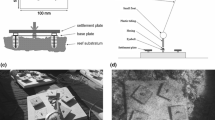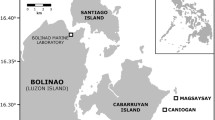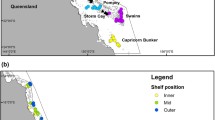Abstract
For marine organisms, decoupling between the planktonic larval stage and the benthic-associated juvenile stage can lead to variable patterns of population replenishment, which have the potential to influence the effectiveness of marine reserves. We measured spatial and temporal variability in larval supply and recruitment of fishes to coral reefs of different protection levels and tested whether protection level influenced the relationship between supply and recruitment. We sampled pre-settlement larvae and newly settled recruits from four reefs (two reserves and two non-reserves) in the Florida Keys National Marine Sanctuary, USA. Replicate point measures of larval supply over 14 months and 17 monthly measurements of recruitment varied significantly among months and sites. Sites with the same protection level had significantly different patterns of larval supply as well as larval and recruit diversity, but recruitment magnitude differed only by protection level, where densities were greater at reserves. Differences in larval supply among sites included two particularly large peaks in larval abundance at one site, possibly associated with the observed passage of small-scale oceanographic features. To examine whether relationships between larval supply and recruitment varied by protection level, we selected one species that was present in both the light trap samples and the monthly recruitment surveys. Recruitment of the bicolor damselfish Stegastes partitus was significantly and positively related to larval supply at three of the four sites thus, protection level did not influence this linkage. Since local variability among sites can lead to spatial differences in population replenishment, characterization of larval supply and recruitment to potential marine reserve sites may help to identify optimal locations in a region and contribute to more effective reserve design.





Similar content being viewed by others
References
Bergenius MAJ, Meekan MG, Robertson DR, McCormick MI (2002) Larval growth predicts the recruitment success of a coral reef fish. Oecologia 131:521–525
Caselle JE (1999) Early post-settlement mortality in a coral reef fish and its effect on local population size. Ecol Monogr 69:177–194
Caselle JE, Warner RR (1996) Variability in recruitment of coral reef fishes: the importance of habitat at two spatial scales. Ecology 77:2488–2504
Cowen RK (2002) Oceanographic influences on larval dispersal and retention and their consequences for population connectivity. In: Sale PF (ed) Coral reef fishes. Academic Press, New York, pp 149–170
Criales MM, Yeung C, Jones DL, Jackson TL, Richards WJ (2003) Variation of oceanographic processes affecting the size of pink shrimp (Farfantepenaeus duorarum) postlarvae and their supply to Florida Bay. Estuar Coast Shelf Sci 57:457–468
D’Alessandro E, Sponaugle S, Lee T (2007) Patterns and processes of larval fish supply to the coral reefs of the upper Florida Keys. Mar Ecol Prog Ser 331:85–100
Doherty P, Fowler T (1994) An empirical test of recruitment limitation in a coral reef fish. Science 263:935–939
Graham NAJ, Evans RD, Russ GR (2003) The effects of marine reserve protection on the trophic relationships of reef fishes on the Great Barrier Reef. Environ Conserv 30:200–208
Halpern BS (2003) The impact of marine reserves: do reserves work and does reserve size matter? Ecol Appl 13:S117–S137
Halpern BS, Warner RR (2003) Matching marine reserve design to reserve objectives. Proc R Soc Lond B Biol 270:1871–1878
Hixon MA, Pacala SW, Sandin SA (2002) Population regulation: historical context and contemporary challenges of open vs. closed systems. Ecology 83:1490–1508
Holbrook SJ, Schmitt RJ (2002) Competition for shelter space causes density-dependent predation mortality in damselfishes. Ecology 83:2855–2868
Houde ED (1997) Patterns and trends in larval-stage growth and mortality of teleost fish. J Fish Biol 51:52–83
Lee TN, Rooth C, Williams E, Mcgowan M, Szmant AF, Clarke ME (1992) Influence of Florida Current, gyres and wind-driven circulation on transport of larvae and recruitment in the Florida Keys coral reefs. Cont Shelf Res 12:971–1002
Levin PS (1998) The significance of variable and density-independent post-recruitment mortality in local populations of reef fishes. Aust J Ecol 23:246–251
Limouzy-Paris C, McGowan MF, Richards WJ, Umaran JP, Cha SS (1994) Diversity of fish larvae in the Florida Keys—results from SEFCAR. Bull Mar Sci 54:857–870
Limouzy-Paris CB, Graber HC, Jones DL, Ropke AW, Richards WJ (1997) Translocation of larval coral reef fishes via sub-mesoscale spin-off eddies from the Florida current. Bull Mar Sci 60:966–983
McClanahan TR, Muthiga NA, Kamukuru AT, Machano H, Kiambo RW (1999) The effects of marine parks and fishing on coral reefs of northern Tanzania. Biol Conserv 89:161–182
Meekan MG, Milicich MJ, Doherty PJ (1993) Larval production drives temporal patterns of larval supply and recruitment of a coral reef damselfish. Mar Ecol Prog Ser 93:217–225
Milicich MJ, Meekan MG, Doherty PJ (1992) Larval supply—a good predictor of recruitment of 3 species of reef fish (Pomacentridae). Mar Ecol Prog Ser 86:153–166
Palumbi SR (2004) Marine reserves and ocean neighborhoods: the spatial scale of marine populations and their management. Annu Rev Env Resour 29:31–68
Planes S, Galzin R, Rubies AG, Goni R, Harmelin JG, Le Direach L, Lenfant P, Quetglas A (2000) Effects of marine protected areas on recruitment processes with special reference to Mediterranean littoral ecosystems. Environ Conserv 27:126–143
Richards WJ (2005) Early stages of Atlantic fishes: an identification guide for the western central North Atlantic. CRC Press, Boca Raton
Robertson DR (1990) Differences in the seasonalities of spawning and recruitment of some small neotropical reef fishes. J Exp Mar Biol Ecol 144:49–62
Robertson DR, Green DG, Victor BC (1988) Temporal coupling of production and recruitment of larvae of a Caribbean reef fish. Ecology 69:370–381
Russ GR, Alcala AC (2003) Marine reserves: rates and patterns of recovery and decline of predatory fish, 1983–2000. Ecol Appl 13:1553–1565
Sabates A, Zabala M, Garcia-Rubies A (2003) Larval fish communities in the Medes Islands Marine Reserve (North-west Mediterranean). J Plankton Res 25:1035–1046
Sale PF, Douglas WA, Doherty PJ (1984) Choice of microhabitats by coral reef fishes at settlement. Coral Reefs 3:91–99
Schmitt RJ, Holbrook SJ (2000) Habitat-limited recruitment of coral reef damselfish. Ecology 81:3479–3494
Shanks AL, Grantham BA, Carr MH (2003) Propagule dispersal distance and the size and spacing of marine reserves. Ecol Appl 13:S159–S169
Smith NP, Lee TN (2003) Volume transport through tidal channels in the middle Florida Keys. J Coast Res 19:254–260
Sponaugle S, Cowen RK (1996) Nearshore patterns of coral reef fish larval supply to Barbados, West Indies. Mar Ecol Prog Ser 133:13–28
Sponaugle S, Cowen RK (1997) Early life history traits and recruitment patterns of Caribbean wrasses (Labridae). Ecol Monogr 67:177–202
Sponaugle S, Fortuna J, Grorud K, Lee T (2003) Dynamics of larval fish assemblages over a shallow coral reef in the Florida Keys. Mar Biol 143:175–189
Sponaugle S, Lee T, Kourafalou V, Pinkard D (2005) Florida current frontal eddies and settlement of coral reef fishes. Limnol Oceanogr 50:1033–1048
Sponaugle S, Grorud-Colvert K, Pinkard D (2006) Temperature-mediated variation in early life history traits and recruitment success of the coral reef fish Thalassoma bifasciatum in the Florida Keys. Mar Ecol Prog Ser 308:1–15
Thorrold SR, Shenker JM, Mojica R, Maddox ED, Wishinski E (1994) Temporal patterns in the larval supply of summer-recruiting reef fishes to Lee Stocking Island, Bahamas. Mar Ecol Prog Ser 112:75–86
Tolimieri N (1998) Effects of substrata, resident conspecifics and damselfish on the settlement and recruitment of the stoplight parrotfish, Sparisoma viride. Environ Biol Fish 53:393–404
Tolimieri N, Sale PF, Nemeth RS, Gestring KB (1998) Replenishment of populations of Caribbean reef fishes: are spatial patterns of recruitment consistent through time? J Exp Mar Biol Ecol 230:55–71
Tupper M, Boutilier RG (1997) Effects of habitat on settlement, growth, predation risk and survival of a temperate reef fish. Mar Ecol Prog Ser 151:225–236
Valles H, Sponaugle S, Oxenford HA (2001) Larval supply to a marine reserve and adjacent fished area in the Soufriere Marine Management Area, St Lucia, West Indies. J Fish Biol 59:152–177
Victor BC (1986) Larval settlement and juvenile mortality in a recruitment-limited coral-reef fish population. Ecol Monogr 56:145–160
Warner RR, Swearer SE, Caselle JE (2000) Larval accumulation and retention: implications for the design of marine reserves and essential fish habitat. Bull Mar Sci 66:821–830
Watson M, Munro JL (2004) Settlement and recruitment of coral reef fishes in moderately exploited and overexploited Caribbean ecosystems: implications for marine protected areas. Fish Res 69:415–425
Wilson DT (2001) Patterns of replenishment of coral-reef fishes in the nearshore waters of the San Blas Archipelago, Caribbean Panama. Mar Biol 139:735–753
Zar JH (1999) Biostatistical Analysis. Prentice-Hall, New Jersey
Acknowledgments
We thank E. D’Alessandro, J. Llopiz, S. Cappell, T. Rankin, D. Pinkard, and K. Huebert for help with the light trap collections. Expert aid in larval identification was provided by C. Paris and E. D’Alessandro, who also helped with plankton sample sorting. We thank M. Paddack, K. Denit, D. Pinkard, K. Huebert, E. D’Alessandro, T. Rankin, A. Chapin, C. Boynton, J. Kool, S. Trbovich, C. Guigand, D. Richardson, J. Llopiz, and K. Lamb for help with collecting recruits from the field as part of an ongoing recruitment survey in the upper Florida Keys. Fish were collected under permits # 02R-524A from the Florida Fish and Wildlife Conservation Commission, #2002-025A and 2004–024 from the Florida Keys National Marine Sanctuary, and #01-056 under the UM Animal Care and Use Committee. MODIS ocean color images were provided by University of South Florida Institute for Marine and Remote Sensing. This manuscript benefited from the comments of J. Bohnsack, R. Cowen, J. McManus, S. Sogard, and two anonymous reviewers.
Author information
Authors and Affiliations
Corresponding author
Additional information
Communicated by S.D. Connell.
Rights and permissions
About this article
Cite this article
Grorud-Colvert, K., Sponaugle, S. Larval supply and juvenile recruitment of coral reef fishes to marine reserves and non-reserves of the upper Florida Keys, USA. Mar Biol 156, 277–288 (2009). https://doi.org/10.1007/s00227-008-1082-0
Received:
Accepted:
Published:
Issue Date:
DOI: https://doi.org/10.1007/s00227-008-1082-0




